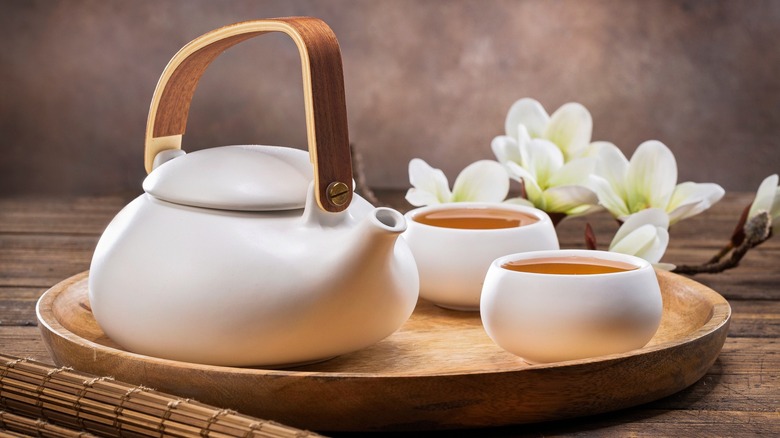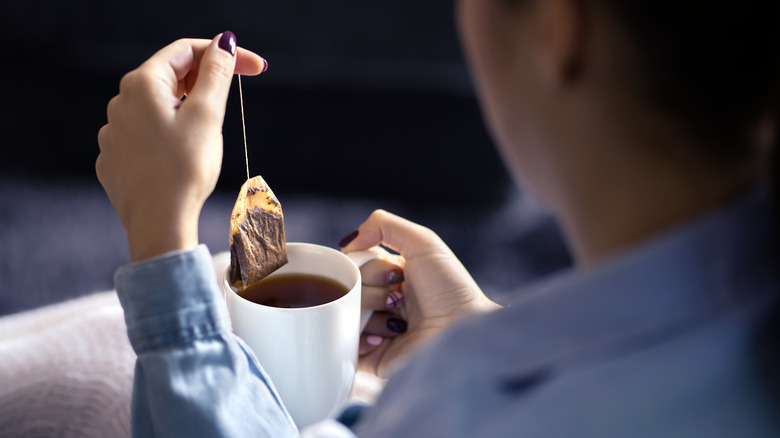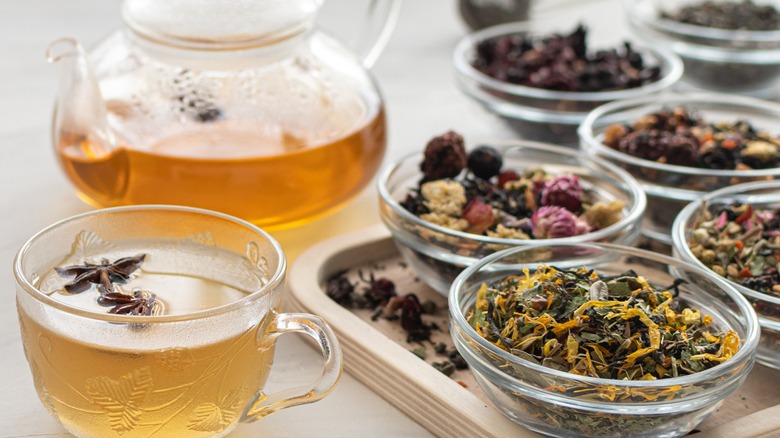The Main Difference Between Steeping And Infusing Tea
Tea drinking is quite like wine drinking in that its complexities and nuances can be inaccessible for the average beverage buff to understand. However, we're here to demystify things by helping you brush up on some common tea vocabulary. From terroir to tea tannins, familiarizing yourself with the tea-drinking lexicon can be daunting, but because steeping and infusing are two of the most important aspects of preparing a cup of tea, knowing the difference between the two is a great place to start.
Steeping tea describes the process of soaking tea leaves, herbs, and spices in water to extract the bold flavors of your blend. When steeped, the dry ingredients of your medley bleed into the water to make tea. Tea is most often steeped in hot water that's just cooled down from a boiling state. Think of infusing tea as a subcategory of steeping. Tea infusions are characterized by the specific flavors in your tea blend. When you steep a tea blend made of lemongrass, chamomile, and lavender, you're infusing the tea with those distinct flavors. Ultimately, you steep tea to infuse it with flavor.
Tips for steeping tea
Steeping tea is an easy, hassle-free process that anyone can perform. However, by keeping a few steeping tips and tricks in mind, you'll avoid some of the common mistakes people make when brewing tea. For starters, always use fresh, filtered water to steep your tea to avoid any impurities that could impact the taste of your beverage. Also, be mindful of how long you steep your tea, as over-steeping leads to bitter, acrid flavors while under-steeping will dilute the taste.
Black tea and teas with fruit and herbal infusions are steeped for three to five minutes, while green, white, and yellow tea blends are steeped for two to three minutes. Don't steep tea in boiling water, wait until it has simmered down just below its boiling point. If you steep tea in too-hot water, it can damage the flavors. If you're steeping loose-leaf tea, use 6 ounces of water for every teaspoon. Pre-packaged tea sachets typically come with instructions, and following them carefully guarantees a flavorful cup of tea for breakfast, lunch, dinner, or bedtime.
Tips for infusing tea
Between timing and temperature and tallying ratios, steeping is a careful science that doesn't leave much room for innovation. Infusing, however, is a creative process that benefits from imagination. That being said, there are still some guidelines for infusing tea. First, start with fresh ingredients for your blend. A high-quality tea blend should have a strong, fragrant aroma and a noticeable flavor. If the blend smells or tastes flat, brew a different blend.
Because it's made from dry ingredients, tea has a considerably long shelf life, but if you notice mold, pests, or any other organic growth, dispose of your blend as soon as possible. Infusions are all about flavor, but avoid using too many ingredients at once. Although mixing and matching is encouraged, an exaggerated amount of ingredients prevents you from tasting them. Consider using no more than three base ingredients and two complementary ingredients. And when crafting a tea blend, avoid using overpowering flavors.
Focus on complementary ingredients that either enhance or curb each other's flavors. For example, floral blends featuring lavender or chamomile are bolstered by citrus infusions for a bright, summery beverage or sharpened with spices for a slightly less flowery taste. On the contrary, a blend of ginger, black pepper, and turmeric might be too spicy. Whether making "adult" tea, like this spiked peach herbal sweet tea, or hosting a party, brewing the perfect pot of herbs doesn't have to be daunting. As long as you get comfortable with steeping and infusing, you'll be a tea pro faster than you can say "chamomile."


